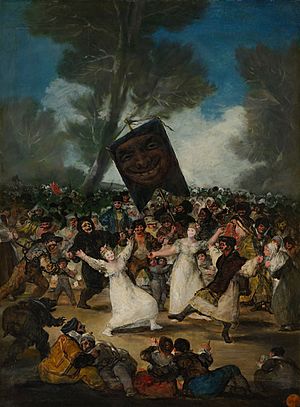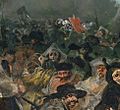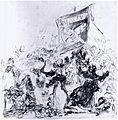The Burial of the Sardine facts for kids
Quick facts for kids The Burial of the Sardine |
|
|---|---|
| Spanish: El entierro de la sardina | |
 |
|
| Artist | Francisco Goya |
| Year | c. 1812–1819 |
| Type | Oil on wood |
| Dimensions | 82.5 cm × 62 cm (32.5 in × 24 in) |
| Location | Real Academia de Bellas Artes de San Fernando, Madrid |
The painting The Burial of the Sardine (in Spanish, El entierro de la sardina) was created by the Spanish artist Francisco Goya. It is an oil painting on a wooden panel. Most experts believe Goya painted it between 1812 and 1819. The title was given to the painting after Goya's time. It refers to a fun, traditional event in Madrid during carnival. This event, called Entierro de la Sardina, marks the end of a three-day celebration. It happens just before Ash Wednesday, which starts Lent.
In the painting, you can see people in masks and costumes. They are dancing their way to the banks of the Manzanares river. There, a special sardine will be buried in a ceremony. Goya did not paint the actual fish or a large straw doll that usually holds it. Instead, the main focus is a darkly smiling character. This character is known as the "King of the Carnival."
What the Painting Shows
This artwork shows a lively carnival celebration. It captures a moment of fun and excitement. The painting is a tribute to everyday people. It shows a happy crowd enjoying themselves on the first day of Lent. This is a time when many other Spanish Catholics would be at church.
A Closer Look at the Party
Even though it's a celebration, the painting has a slightly mysterious feel.
- Many faces are hidden by masks or look blank.
- The trees are grey and twisted.
- Dark colors seem to be creeping into the scene.
- There is a striking black banner. It carries a strange symbol.
These details give the celebration a different mood. Festivals like the "Burial of the Sardine" often had themes about life and death. People wore masks to keep away bad spirits or to protect themselves. The word "mortus," meaning "death," can barely be seen on the banner. In one of Goya's early sketches, this word is much clearer.
Goya's Changing Art Style
Experts have dated this painting to different times, from 1793 to 1819. However, most agree it was painted later in this period. This is because of Goya's painting style. His art changed a lot as he got older.
From Bright to Darker Works
The Burial of the Sardine seems to fit into a journey in Goya's art:
- Early works: Goya started with bright, cheerful paintings. He often painted popular events and colorful designs for tapestries.
- Later works: His art became more serious and sometimes darker. These later works are known as his Black Paintings.
The Burial of the Sardine is seen as a bridge between these two periods. It has the wild joy of his early works. But it also shows the deeper, more unsettling feelings found in his later art. Goya used his brushstrokes with great skill. Every stroke helps to show the feelings on the faces and in the movements of the people.
Other Related Paintings
This painting is part of a group of artworks Goya made around the same time. These paintings also show religious ceremonies. Some examples include:
- A Procession of Flagellants (Procesión de disciplinantes)
- Inquisition Scene (Auto de fe de la Inquisición)
Gallery
See also
 In Spanish: El entierro de la sardina para niños
In Spanish: El entierro de la sardina para niños
- List of works by Francisco Goya



